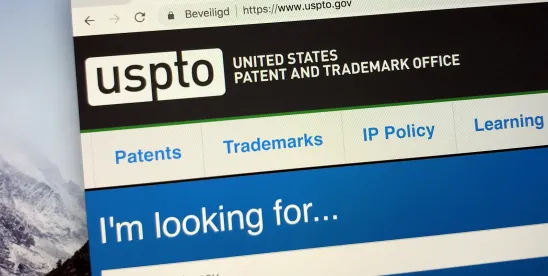Recognizing a need for clarity in evaluating patent eligibility under 35 U.S.C. § 101 for critical and emerging technologies, including artificial intelligence (AI) innovations, the U.S. Patent and Trademark Office (USPTO) released updated guidance effective July 17, 2024. By necessity, businesses involved in developing AI solutions rely on this clarity and guidance in order to effectively plan and implement their research and development resources. Further, patent claims for AI inventions may involve abstract ideas, such as algorithms or mathematical concepts, which are traditionally excluded from patent-eligibility.
The updated examination guidance (2024 Updated Guidance) provides AI-inventive companies with beneficial context and additional clarity in shaping patent and comprehensive IP protection programs. This updated guidance builds on recent USPTO guidance addressing other aspects of AI innovations, most notably the requirement that where AI is used in creating or developing an invention, a human must have made a “significant contribution” to the invention.
In its publication, the USPTO updates its guidance to examiners and the public from its 2019 Revised Patent Subject Matter Eligibility Guidance (2019 Guidance). The 2019 Guidance introduced Prongs 1 and 2 of Step 2A for determining whether a claim is directed to a judicial exception, and was eventually adopted into section 2106 of the Manual of Patent Examining Procedure (MPEP).
In the 2019 Guidance, the USPTO implemented its two-pronged inquiry to evaluate the first step of the Alice/Mayo test (often referred to as Step 2A) for determining whether a claim is directed to a judicial exception, such as an abstract idea. The first inquiry (Step 2A, Prong 1) asks whether a claim recites a judicial exception, warranting further analysis. The second inquiry (Step 2A, Prong 2) asks whether the claim integrates the alleged judicial exception into a practical application. The 2024 Updated Guidance includes additional considerations and examples to aid in determining whether a claim is directed to an abstract idea under Prongs 1 and 2 of the Step 2A.
Updates to Step 2A, Prong 1: Whether a Claim is Directed to an Abstract Idea
For Prong 1, the 2019 Guidance requires the USPTO examiner to determine whether a claim recites features that fall within one or more groups of abstract ideas: mathematical concepts, certain methods of organizing human activity, or mental processes.
The 2024 Updated Guidance enumerates a list of examples that are clearly not an abstract idea, including:
- An application-specific integrated circuit (ASIC) for an artificial neural network, including an array of neurons, each with a register, processing element, and at least one input. These neurons are interconnected via multiple synaptic circuits, each containing memory to store synaptic weights. (Claim 1, Example 47 of 2024 Updated Guidance)
- A system for monitoring the health and activity of dairy livestock, including a memory and a processor with executable instructions. These instructions feature a livestock interface to obtain animal-specific information, such as identification, body position, temperature, feeding behavior, and movement patterns. The system also has a herd monitor with a radio frequency reader to collect data from sensors attached to the animals and a transmitter to send this information to the livestock interface. (Claim 4, Example 46 of 2024 Updated Guidance)
- Claims involving a method for operating a flow cytometry apparatus to classify and sort particles in real time do not constitute an abstract idea despite involving mathematical concepts. See XY, LLC v. Trans Ova Genetics. These claims are eligible because they do not recite a mathematical concept or any other abstract idea under Step 2A, Prong One.
- Claims directed toward “a specific, hardware-based RFID serial number data structure” (i.e., an RFID transponder), where the data structure is uniquely encoded to establish a unique correspondence between the data physically encoded on the RFID transponder and pre-authorized blocks of serial numbers. See ADASA Inc. v. Avery Dennison Corp., 55 F.4th 900, 909 (Fed. Cir. 2022). These claims are clearly not directed to a mental process.
The 2024 Update Guidance further then indicates examples of claims that fit within the various types of abstract ideas:
- Certain methods of organizing human activity, specifically “managing personal behavior or relationships or interactions between people”:
- Claims for collecting information on a user’s movements and location history and electronically recording that data (i.e., “creating a digital travel log”). See Weisner v. Google LLC, 51 F.4th 1073, 1082 (Fed. Cir. 2022). This is an example of managing personal behavior or relationships or interactions between people.
- Claims for monitoring the location of a mobile thing and notifying a party in advance of its arrival are considered fundamental business practices, akin to long-established methods of advising customers about the status of their deliveries. See Elec. Commc’n Techs., LLC v. ShoppersChoice.com, LLC, 958 F.3d 1178, 1181 (Fed. Cir. 2020).
- Claims for methods of detecting fraud in financial transactions during the payment clearing process involve determining matches between financial records, notifying the bank to authorize the transaction if there is a match, and notifying the bank to halt the transaction if there is no match. This is considered a fundamental economic principle or practice. See Bozeman Fin. LLC v. Fed. Reserve Bank of Atlanta, 955 F.3d 971, 978 (Fed. Cir. 2020).
- Mental processes:
- Claims directed toward a method of “(1) receiving user information; (2) providing a polling question; (3) receiving and storing an answer; (4) comparing that answer to generate a ‘likelihood of match’ with other users; and (5) displaying certain user profiles based on that likelihood” could practically be performed in the human mind (i.e., “[a] human mind could review people’s answers to questions and identify matches based on those answers”). See Trinity Info Media, LLC v. Covalent, Inc., 72 F.4th 1355, 1362 (Fed. Cir. 2023).
- Claims involving “the collection of information from various sources (a U.S. Federal database, a U.S. State database, and a case worker) and understanding the meaning of that information (determining whether a person is receiving SSDI benefits and whether they are eligible for benefits under the law)” can be practically performed by a human. These steps involve making determinations and identifications through observation, evaluation, judgment, and opinion, which are routine mental tasks for humans. See In re Killian, 45 F.4th 1373, 1379 (Fed. Cir. 2022).
- Claims involving “the use of an algorithm-generated, content-based identifier to perform data-management functions,” such as “controlling access to data items,” “retrieving and delivering copies of data items,” and “marking copies of data items for deletion,” amount to a series of mental processes. These steps, taken together, form a multistep mental process that can be practically performed in the human mind. See PersonalWeb Techs. LLC v. Google LLC, 8 F.4th 1310, 1316-18 (Fed. Cir. 2021).
Updates to Step 2A, Prong 2: Whether the Abstract Idea is Integrated Into a Practical Application
For Prong 2, the 2019 Guidance requires an examiner to determine whether the claim, as a whole, incorporates the alleged abstract into a practical application of that abstract idea. The 2024 Updated Guidance further explains that claim features should “apply, rely on, or use the judicial exception in a manner that imposes a meaningful limit on the judicial exception.”
In the field of AI technologies, applicants often satisfy Step 2A, Prong 2, by showing that the AI invention “improves the functioning of a computer or improves another technology or technical field,” sometimes shortened to as a “technical solution to a technical problem.”
The 2024 Updated Guidance acknowledges that “many claims to AI inventions are eligible as improvements to the functioning of a computer or other technology.” The 2024 Updated Guidance attempts to clarify the distinction between claims that are eligible as improvements to a computer or technology and those that are not. The 2024 Updated Guidance clarifies that eligible claims must demonstrate a specific improvement as described in the specification.
The 2024 Updated Guidance provides examples of claims that sufficiently describe “improvements” and therefore satisfy Step 2A, Prong 2:
- Claims for a method of resolving a “haplotype phase involving steps of determining an inheritance state based on received allele data using a Hidden Markov Model,” did not provide an improved technological improvement. Even though the technology described in the patent “yield[ed] a greater number of haplotype phase predictions,” the claims described an improved mathematical process. See In the Board of Trustees of Leland Stanford Junior University, 989 F.3d 1367, 1370, 1373 (Fed. Cir. 2021).
- Claims for a rule-based system to animate lip synchronization provided a technological improvement because the claims incorporated a particular set of functional rules for computer animation that improved the existing technological process. These claimed rules enabled the automation of specific animation tasks that previously could not be automated. See McRO, Inc. v. Bandai Namco Games America Inc, 837 F.3d 1299 (Fed. Cir. 2016).
- Claim for “a specific, hardware-based RFID serial number data structure” (i.e., an RFID transponder), where the data structure is uniquely encoded to ensure a unique correspondence between the data physically encoded on the RFID transponder and pre-authorized blocks of serial numbers. This hardware-based data structure focuses on improving the technological process of data encoding. See ADASA, 55 F.4th at 909.
- Claims involving error correction and detection encoding, where information bits are organized into a variable number of subsets, focus on enhancing data encoding through irregular repetition. This is considered an improvement to data encoding rather than an abstract idea. See Cal. Inst. of Tech. v. Broadcom Ltd, 25 F.4th 976, 988 (Fed. Cir. 2022).
- Claims related to a packet monitor that identifies disjointed connection flows as part of the same conversational flow are considered an improvement in computer technology, not an abstract idea. See Packet Intel. LLC v. NetScout Sys., Inc., 965 F.3d 1299, 1308-10 (Fed. Cir. 2020).
- Claims for a primary station in a communication system, which include an additional data field to allow simultaneous sending of inquiry messages and polling of parked secondary stations, are considered an improvement in computer functionality. This improvement specifically reduces latency for parked secondary stations, rather than being an abstract idea. See Uniloc USA, Inc. v. LG Elec. USA, Inc., 957 F.3d 1303, 1305, 1307-08 (Fed. Cir. 2020).
- Claims to a cardiac monitoring device that analyzes the variability in the beat-to-beat timing for atrial fibrillation and atrial flutter to more accurately detect the occurrence of these cardiac conditions were directed to an improvement in cardiac monitoring technology and not an abstract idea. See CardioNet, LLC v. InfoBionic, Inc., 955 F.3d 1358, 1368-69 (Fed. Cir. 2020).
- Claims involving the variation of check data generation by modifying the permutation applied to different data blocks are seen as an improvement in the technological process for detecting systemic errors in data transmission, rather than an abstract idea. See Koninklijke KPN N.V. v. Gemalto M2M GmbH, 942 F.3d 1143, 1150-51 (Fed. Cir. 2019).
The USPTO also provided eligibility analysis based on hypothetical claims:
- Example 47 illustrates the application of the eligibility analysis to claims that recite limitations specific to AI, particularly the use of an artificial neural network to identify or detect anomalies.
- Example 48 illustrates the application of the eligibility analysis to claims that recite AI-based methods of analyzing speech signals and separating desired speech from extraneous or background speech.
- Example 49 illustrates the analysis of method claims reciting an AI model that is designed to assist in personalizing medical treatment to the individual characteristics of a particular patient.
The 2024 Updated Guidance emphasizes that the Federal Circuit relied on the specification’s explanation of how the claimed rules enabled the automation of specific tasks (among others) that previously could not be automated, thereby accentuating the importance of describing the technical improvement in the specification.
Impacts to Businesses
The new guidance assists companies involved in AI development and innovation by providing additional clarity for evaluating patentability and related IP protection strategies and programs. Claims for AI-related inventions may be interpreted as being directed to abstract ideas (i.e., mathematical concepts, methods of organizing human activity, and mental processes), which have been excluded from patentability. When drafting AI invention claims, practitioners must ensure they reflect genuine technological improvements and provide specific solutions to problems. The guidance, including the examples, may provide useful templates for pursuing patent protection for AI technologies.






 />i
/>i

